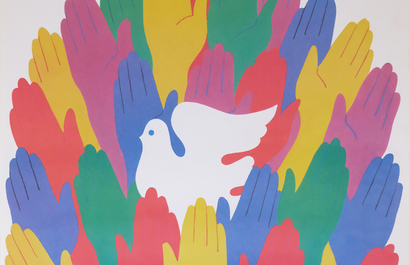A Conversation about Conservation: How to Store, Frame and Protect your Artwork

For every poster that makes it to our website, at least two don’t. We often come across a rare poster only to find half of it missing, or the image destroyed by water.
Posters were designed to be disposable. They were printed by their thousands on cheap paper, and were thrown away when the movie or movement was over. The illustrations were just an aid to communicate a message. They weren’t valued for their artistic merit at the time. The few that survived were peeled off walls or taken from theatre lobbies by collectors. Most of them ended up in basements where water, termites and time destroyed them.
I caught up with expert conservators Roo and Maartje from Foley Schalkx Conservation, to learn more about conservation and caring for art. Roo and Maartje started Foley Schalkx in 2017, and have conserved works by artists including Basquiat, Bacon, Banksy, Dali and Cezanne.
Below is a summary of our conversation, edited for clarity.

What is the Difference Between Conservation and Restoration?
Restoration focuses on bringing an artwork back to its original appearance, and less on the long-term condition. Conservation primarily focuses on long-term preservation. The appearance of the artwork comes second to its preservation.
When we conserve an artwork, we’ll never try to disguise the fact that work has been done. In fact, conservators create detailed records to accompany artworks, so anyone working on it in the future knows what has been done previously. Conservation combines scientific research and knowledge of materials with techniques based on traditional craftsmanship and intuition. The tricks of the trade are learnt on the job and there is no one standard approach.
When an Artwork has Paper Loss, What are the Steps you Take to Conserve it?
Up to the 19th century, paper was made from cotton or linen rags, but that changed to trees when demand from the paper industry outgrew the rag trade. Cotton and linen rag papers age well, while paper which is made from wood pulp will age much faster. That’s why a newspaper left by a window for a couple of days will begin to discolour. Paper is a strong material, but with age and handling, tears and breaks will form. Many posters, especially East German ones, were factory folded after printing. Folding made them easier to transport and for the workers to paste them up on walls. As a result, you’ll often find paper separation along the folds, which is the weakest part of an artwork.
When an artwork has paper separation or paper loss, we’ll infill it with Japanese paper which has been around for centuries. Japanese paper can be as thin as 2 GSM - for comparison the average A4 printer paper is around 80 GSM. We match the colour of the artwork by dyeing the paper and then build up the thickness of the paper to match the artwork.
Linen backing used to a common way to protect posters. We don’t recommend it, as both linen and paper react differently to humidity and temperature. When exposed to humidity, paper expands, while textiles like linen contract. This creates tensions between paper and textile, which can result in a rippling effect, and in turn breaks and tears. If your artwork is already in poor condition, backing may be necessary. Instead, you should have it lined with Japanese paper which will move with the artwork.
How Should I Store my Artwork?
Exposure to any light has an irreversible impact on an artwork. That’s why nearly half of Pablo Picasso’s oil paintings are kept in storage. The best way to protect your artwork is to keep the relative humidity and temperature consistent. The ideal temperature and relative humidity for works on paper are 13°C to 20°C and 25% RH to 60% RH. Avoid hanging artwork near sources of heat or moisture like radiators or sinks. Above 65% RH there is an increased risk of mould growth so be sure to avoid damp spaces such as bathrooms, attics and basements. If your work is not hung, it should be laid flat. We recommend against rolled storage, but if space is an issue, you can wrap it in acid free tissue paper to reduce the risk of acid migration from the cardboard tube.

Framing is Complex, Confusing and Expensive. Do you have any Recommendations?
A good quality frame will protect your artwork, preserving it for years to come. A skilled framer will guide you through the process, but here’s what you can look for.
Framing - The frame should be rigid and protect your artwork from knocks and bumps. It should be possible to open up the frame with relative ease so that there is little risk of damaging the artwork when removing it. Staples and nails should be avoided as they are difficult to remove. The backboard should be acid-free and if the artwork is being framed to the edge then the frame should be foil lined to prevent acid-migration from the wood into the paper. Fillets which are in direct contact with the artwork should be paper-wrapped at minimum to reduce the risk of acid-migration.
Mounting - The mat or mountboard supports the artwork inside the frame. It acts as a barrier between the backboard and the artwork. It should be acid-free and buffered at minimum. The gold standard is 100% cotton rag. The artwork can be mounted to the mountboard using different techniques. If paper photo-corners aren’t an option then we would recommend Japanese paper hinges applied using Japanese wheat starch paste. Pressure sensitive adhesive tapes, i.e. sticky tapes, should generally be avoided as their adhesives tend to be unstable which causes discolouration over time.
Glass or Glazing - You can use glass or acrylic glazing in your frame, but it should offer at least 99% UV protection. This will minimise light damage caused by ultraviolet light. You should also hang your artwork away from direct sunlight.
Thanks to Roo and Maartje from Foley Schalkx Conservation for sharing their time and knowledge. You can visit their website here or shop a few of my favourite film posters below.






